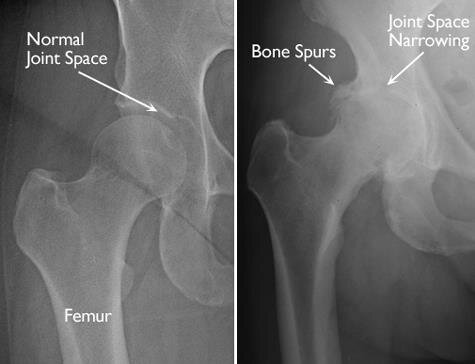Hip Arthritis
WHAT IS THE HIP JOINT?
The hip joint is a ball and socket joint. The femoral head is the ball at the top of your thigh bone (femur), which sits inside the socket (acetabulum) in the bones of your pelvis. The ball and socket are both covered by a thin layer of articular cartilage. This is the smooth surface which allows your hip to move freely without friction. Around the edge of the socket is another layer of fibrocartilage called the labrum. This cartilage is strong and helps deepen the hip joint and provide stability to your hip. The whole joint is surrounded by a layer of fibrous tissue called the hip capsule. This separates the joint from the surrounding muscles and tendons.
What is arthritis?
Arthritis is a general term covering numerous conditions where the joint surface (cartilage) wears out. The most common form of hip arthritis is osteoarthritis. Osteoarthritis is a degenerative type of arthritis in which the cartilage in the hip joint gradually wears away over time. As the cartilage wears away it becomes frayed and rough, and the normal joint space between the bones decreases. Eventually all of the cartilage is lost, and this leads to bone rubbing on bone. To make up for the lost cartilage, the damaged bones may start to grow bone spurs called osteophytes. Osteoarthritis develops slowly and the pain it causes worsens over time. As well as osteoarthritis there are many other (less common) forms of arthritis. These include:
Inflammatory arthritis: Rheumatoid arthritis, ankylosing spondylitis, psoriatic arthritis
Post-traumatic arthritis (injury related)
Post-infection arthritis
Arthritis secondary to childhood conditions: hip dysplasia, Perthes disease, slipped upper femoral epiphysis (SUFE)
Avascular necrosis.
What causes arthritis?
Osteoarthritis has no single specific cause, but there are certain factors that may make you more likely to develop the disease. These include:
Increasing age
Family history of osteoarthritis
Previous injury to the hip joint
Obesity
Improper formation of the hip joint at birth, a condition known as developmental dysplasia of the hip.
Even if you do not have any of the risk factors listed above, you can still develop osteoarthritis.
What are the symptoms of hip arthritis?
The main symptom of hip arthritis is pain in the hip joint. This is most commonly felt in the groin, and can travel down the thigh all the way to your knee. Pain is usually worse with activity such as getting up from a chair, standing or walking. Pain at night with sleep disturbance is also common. You or others may notice that you limp or sway when walking. As arthritis progresses your hip joint also becomes stiff, and may make a grinding noise (crepitus) with movements. Reaching down to put on socks or shoes, cut your toenails, or even put on trousers can become difficult.
How is hip arthritis diagnosed?
Hip arthritis can usually be identified from your symptoms and a clinical examination. A standard x-ray of your hip joint is usually enough to confirm the diagnosis of arthritis. X-rays may show narrowing or loss of the joint space, thickening of the bone (sclerosis) and the formation of bone spurs (osteophytes) around the ball of the hip. Occasionally in very early arthritis an MRI scan is needed to identify cartilage damage.
Normal hip on the left, arthtic hip on the right
What is the treatment for hip arthritis?
Although there is no medical cure for osteoarthritis, there are a number of treatment options that can help to relieve pain and improve mobility. The initial treatment for hip arthitis is non-surgical, and includes a number of simple measures which can help maintain your quality of life and activity levels. These include:
Keeping fit and strengthening the muscles in your hip and leg with regular excerise (if needed a physiotherapist can provide you with an individualised exercise programme)
Putting less stress on your hip by switching from high-impact activities (like long walks, jogging or tennis) to lower-impact activities (like swimming or cycling)
Losing weight, which can reduce stress on the hip joint. This results in less pain and increased function.
Taking regular simple pain relief medication such as paracetamol or anti-inflammatory medication such as ibuprofen, Voltaren or Celebrex can help you stay active and delay the need for surgery
Using a cane or walking stick in the opposite hand from your arthritic hip can reduce the pressure in your hip when walking, which decreases pain.
Surgical treatment
When your arthritis progresses to the point that it no longer responds to conservative treatment you are likely to require total hip replacement surgery. Hip replacement is one of the most effective operations in the world and should give you many years of pain-free mobility. Other operations such as hip resurfacing have been used in the past, but these have high complication rates and are now seldom performed. Please click this link to learn more about hip replacement.


